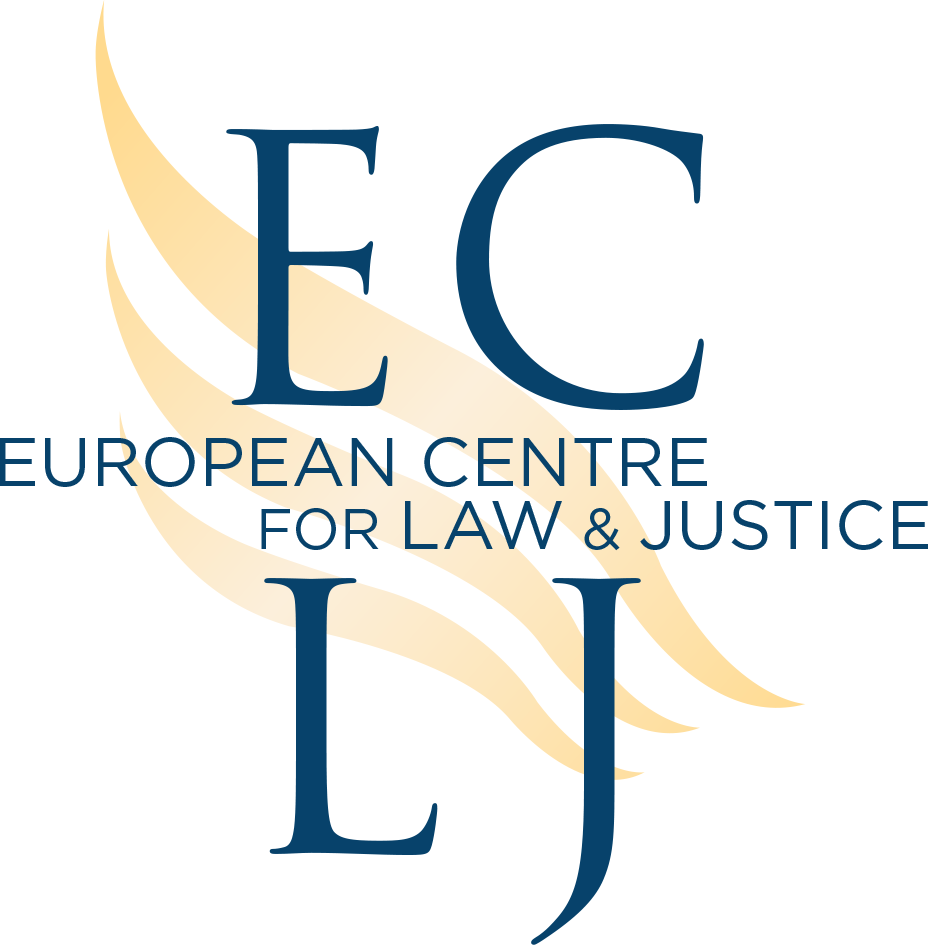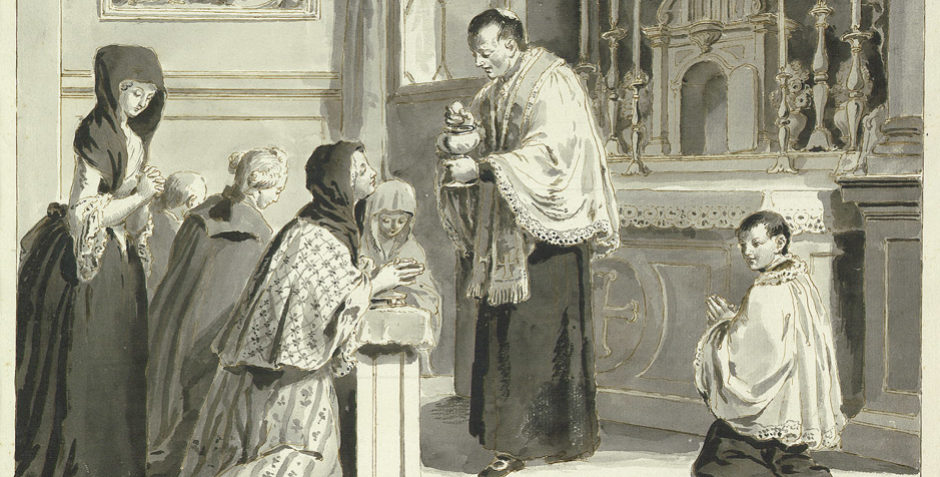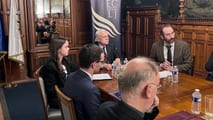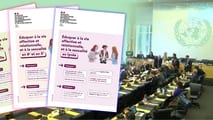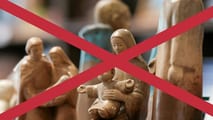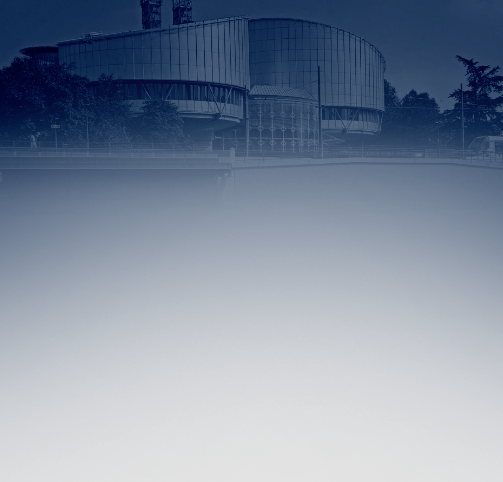Update: the ECHR communicated the case on 20 June 2019 (n°22604/18).
The Spanish Association of Christian Lawyers – Asociación de Abogados Cristianos – lodged an application with the European Court of Human Rights (ECHR) with the help of the ECLJ, following the host desecration by the “artist” “Abel A.” The contentious “work of art” was composed of 242 hosts stolen during several Masses and then arranged on the ground to write the word “pederastia”. The “artist” was then photographed naked with his “work” and exhibited the photos. Born in 1988 in Pamplona, “Abel A.” had already been noticed for his photos of female genitals and for a video of him eating a Koran.[1] He wants to “stir up trouble” with his art, in order to “take revenge” on society.[2]
The Association of Christian Lawyers filed a complaint, which was rejected by the court of Pamplona on November 18th, 2016. The judge Fermin Otamendi described the consecrated hosts as “small white round objects,” that “Abel A.” would have treated “discreetly, without his conduct being able to be characterized as disrespectful, offensive or irreverent.”[3] The magistrate also claimed that the Catholic Church could not require people to use the hosts in a manner consistent with its instructions. The Association of Christian Lawyers made an appeal against this judgment to the Constitutional Court of Spain, which took a decision of inadmissibility on November 7th, 2017. The Spanish domestic courts therefore considered that the protection of the religious feelings of Catholics did not justify a restriction of the freedom of expression of the “artist.”
This case of host desecration poses a key question: did the Spanish courts fairly balance the right to freedom of expression of the “artist” with the right to freedom of religion of Catholics? In other words, are the theft of hosts and their desecration compatible with the “peaceful enjoyment of the right guaranteed under Article 9”[4] of the European Convention of Human Rights[5] ?
A wide but limited national margin of appreciation
If the ECHR accepts the application, it will probably recognize a wide margin of appreciation to the Spanish authorities to assess the rights and interests involved in this case. Indeed, the application concerns “freedom of expression in relation to matters liable to offend intimate personal convictions within the sphere of morals or, especially, religion.”[6] On such questions, the Court does not discern “throughout Europe a uniform conception of the significance of religion in society.”[7] For that reason, it is up to the States first and possibly after to the Court to determine “what constitutes a permissible interference with the exercise of the right to freedom of expression where such expression is directed against the religious feelings of others.”[8]
Although it is broad, the national margin of appreciation is never unlimited. The ECHR thus regularly controls the conventionality of State restrictions on freedom of expression in religious matters. Let us take the example of two recent cases. In the decision Sekmadienis Ltd. v. Lithuania[9], the Court considered that the prohibition of advertisements blaspheming against Jesus and the Virgin Mary was not justified by sufficient grounds. The judges therefore ruled in favor of the clothing manufacturer, whose freedom of expression would have been violated by the Lithuanian State. Similarly, in the decision Mariya Alekhina and others v. Russia of July 2018[10], the ECHR examined the condemnation of the feminist band Pussy riot for invading the Cathedral of Christ the Saviour of Moscow in 2012 and singing a blasphemous and crude “punk prayer.” The Court considered that if their two-year prison sentence pursued a legitimate aim, it was nevertheless a “disproportionate” restriction on their freedom of expression.
The case of the Spanish exhibition is a different situation. In such an extreme case of desecration, there is little doubt that the ECHR would recognize the possibility for a State to restrict freedom of expression. However, the Spanish authorities did not make this choice. Not only was the “artist” not sentenced, but his exhibition entitled “Amen” was even subsidized by the city of Pamplona. The Court will therefore have to determine whether Spain had a positive obligation to prohibit or restrict access to the exhibition under Article 9 of the European Convention. In other words, the question is whether the offense to the religious feelings of believers would have required, in this case, a conviction of “Abel A.” The Association of Christian Lawyers asks the Court, in a way, to be less liberal than Spain in terms of freedom of expression, in order to protect the religious feelings of Catholics.
Although such a situation is not usual, the legal reasoning of the ECHR will have to be based, as often, on balancing two rights. Indeed, the European judge is led to control that Spain has fairly reconciled the right to freedom of expression of the “artist” and the “right to protection of religious feelings as an aspect of religious freedom.”[11] In other words, the Court must check whether it is compatible with the European Convention to accept an exhibition that infringes on the freedom of religion of Catholics.
International obligation of States to prohibit incitement to intolerance
The ECHR interprets the European Convention in the light of the relevant norms of international law. The International Covenant on Civil and Political Rights (ICCPR) of December 16th, 1966, obliges States to prohibit by law “any advocacy of (...) religious hatred that constitutes incitement to discrimination, hostility or violence shall be prohibited by law” (Article 20). The UN Human Rights Committee considers that this provision implies “a law making it clear that propaganda and advocacy as described therein are contrary to public policy and providing for an appropriate sanction in case of violation.”[12] The Committee also called on States to “adopt strong measures to prevent and prohibit the advocacy of hate and intolerance” in order to “fulfil the provisions of article 20 of the Covenant.”[13] More specifically, Ingibjörg Sólrún Gísladóttir, Director of the Office for Democratic Institutions and Human Rights (ODIHR) – institution of the Organization for Security and Co-operation in Europe (OSCE) – “[stressed] the need to address the root causes of intolerance in general, which can give rise to wider conflict and violence, and specifically, [causes of] intolerance against Christians.”[14]
However, more restrictive interpretations of Article 20 of ICCPR also exist and were favored by the ECHR in the case Mariya Alekhina[15]. In particular, Asma Jahangir, the former Special Rapporteur on freedom of religion or belief, and Doudou Diène, the Special Rapporteur on contemporary forms of racism, racial discrimination, xenophobia and related intolerance, note that “article 20 of the Covenant was drafted against the historical background of the horrors committed by the Nazi regime during the Second World War” and therefore “the threshold (...) is relatively high.”[16] Moreover, according to them, “any attempt to lower the threshold of Article 20 of the Covenant would not only shrink the frontiers of free expression, but also limit freedom of religion or belief itself.”[17] In quoting this report, the Court shows that it tries not to interpret the “advocacy of religious hatred” too broadly. That said, even with such an interpretation, Article 20 of ICCPR gives the judges a legal basis for requiring States to restrict religious intolerance.
In the present case, the exhibition of “Abel A.” is clearly an incitment to “religious hatred” and a fortiori an “advocacy of intolerance” against Catholics. It is even difficult to imagine a more extreme case of desecration than this one. Indeed, the Catholic dogma of transubstantiation establishes that bread and wine become by consecration the body and blood of Christ.[18] The consecrated hosts are therefore not a mere symbol, but each is the body of Christ, that is to say Jesus Himself who is God and Son of God. For this reason, the desecration of consecrated hosts is not only a sacrilege (a grave sin), but the worst sacrilege of all.[19] When a Catholic commits such an act, he incurs latae sentenciae excommunication, the most severe canonical punishment.[20] If the Court renounces restricting the freedom of an “artist” to incite so clearly to religious hatred and intolerance, it would mean that everything is permitted against Christians.
In view of the case-law, the ECHR could condemn the Spanish State because its courts have not considered several significant elements.
A gratuitously offensive “work of art” deliberately targeting Catholics
“Abel A.” made the choice to use consecrated hosts, which he stole by participating in 242 masses in Madrid and Pamplona. Yet, it would have been much easier to make exactly the same creation by buying (non-consecrated) hosts. To use the reasoning of the Spanish judge María Elósegui Ichaso in Mariya Alekhina, the aim of the artist (questionning what is sacred) does not justify the clearly disproportionate means he used.[21] “Abel A.” declared to a Spanish radio that his choice was intended to offend Catholics: “It did matter to me that they valued [the hosts].”[22] In fact, to be hurt by the contentious “work of art,” one must believe in the Catholic conception of the Eucharist. Moreover, the attack of “Abel A.” is totally gratuitous, since his “work” does not contribute to the public debate.
According to its case-law, the European Court should be careful to this aspect of the case. In the 1994 decision Otto-Preminger-Institut v. Austria, the ECHR had ruled that the dissemination of a blasphemous film constituting “abusive attack on the Roman Catholic religion”[23] could be banned, even though the film claimed to be artistic and required the payment of an entrance fee. The Court noticed “provocative portrayals of objects of religious veneration” “gratuitously offensive to others.”[24] The film was considered as a “malicious violation of the spirit of tolerance, which must (...) be a feature of democratic society.”[25] The Court ruled that the film's ban was intended to ensure “peaceful enjoyment of the right guaranteed under Article 9” of the European Convention of Human Rights. The Spanish case of desecration is comparable, which could lead the Court to accept the request and to agree with the Association of Christian Lawyers.
A highly publicized desecration and a benefice of 300,000 euros for the “artist”
The exhibition “Amen” took place in premises lent by the city of Pamplona. Through this support, this public institution contributed to the desecration. The exhibition was highly publicized, as shown by numerous articles in the press, reports on radio and television, as well as by the success of a petition, of events, or of Eucharistic adorations and prayers for the repair of the desecration. The “artist” is delighted with these various reactions, especially those of bishops, priests and believers, as shown by his website.[26] The scope of the case is related to the fact that 68% of Spanish people claim to be Catholics.[27] The controversy helped the “artist” to sell his creation for nearly 300,000 euros at the end of the exhibition.
This information speaks in favor of the legitimacy of a restriction of the right to freedom of expression of “Abel A.” Indeed, the ECHR pays attention to the scope and the publicity of the offending message.[28] Moreover, when a large majority of citizens is affected, the European Court in principle offers a better protection of the religious feelings. In Otto-Preminger, the Court stated in this way that it could not “disregard the fact that the Roman Catholic religion is the religion of the overwhelming majority of Tyroleans.”[29] Furthermore, the Strasbourg judges give less protection to a contentious expression aiming to make profit, which is the case here.[30]
The hostility and contempt of the Spanish courts towards the Christian faith
The Pamplona judge Fermin Otamendi claimed to give an objective definition of consecrated hosts - “small white round objects.” This definition does not distinguish between consecrated and non-consecrated hosts and reveals the judge's personal beliefs. However, he should have left aside his own religious feelings, because the case is about protecting those of Catholics and not his own. What mattered for the judgment was therefore to determine with neutrality what mean consecrated hosts for the Spanish Catholics, in other words according to the faith of the Church to which they freely adhere.
The words and the partiality of this judge should undermine the position of the Spanish State. The ECHR could indeed doubt the ability of the Spanish courts to find a balance between the freedoms of expression and of religion in this case. The decision of the United States Supreme Court on June 4th, 2018[31] could influence the ECHR on this point. In that case, the U.S. judges ruled in favor of a Colorado baker who had refused to cook a “wedding” cake for a same-sex couple. The Supreme Court held that the Colorado authorities had shown “obvious and unacceptable animosity” against the baker's Christian faith, whose beliefs were treated as “despicable rhetoric.”[32] As Justice Anthony Kennedy has pointed out, “the law must be applied in a manner that is neutral toward religion.”[33] The Spanish courts seem to have shown the same contempt for Christianity as those in Colorado.
This religious bias of the Spanish justice adds up to the financing of the exhibition by the city. Not only did the Spanish authorities refrain from sanctioning the “artist,” but they even deliberately supported and justified his anti-Christian approach.
The evaluation of the “degree of profanation” by the ECHR
In cases of blasphemy or desecration, the ECHR takes into account the sacredness of the object. By way of illustration, religious leaders, who are part of the official personalities,[34] are less protected than the characters or things considered as “divine” or “sacred.” In the case of Wingrove v. United Kingdom of 1996, the European Court had found it legitimate to protect religious beliefs against a “high degree of profanation,”[35] which must be established on the basis of the degree of sacredness of the desecrated object.
The aforementioned catechism and canon law are not sufficient to establish a “high degree of profanation” in European law. Indeed, the ECHR tends to comprehend religion with an individualist and socioconstructivist interpretation. What matters is not to determine the essence of a religion from its reference texts, but the “intimate religious beliefs and convictions of persons.”[36] The judges pay attention to the “person’s religious beliefs, and their own way of apprehending their personal and social life.”[37] If the ECHR keeps its usual conception of religion, it will wonder how much the Spanish Catholics consider consecrated hosts as sacred, in order to assess the “degree of profanation” of the “work” of “Abel A.”
How do Spanish Catholics bear witness to the Mystery of the Eucharist?
The requirements laid down by the texts in force on the Eucharist should have made it possible to avoid such a massive and serious desecreation.[38] That “Abel A.” could so easily steal 242 consecrated hosts distributed without caution raises questions. This might suggest that Christ has in practice been reduced to an object, available to all, that the priest gives as a vending machine and that the believers take as consumers.
However, this state of affairs should not lead the ECHR to minimize the degree of sacredness of the consecrated hosts and consequently the “degree of profanation” of the sacrilegious act of “Abel A.” Indeed, during the “Amen” exhibition, the Spanish Church strongly reacted to the serious offense suffered by Christ and thus signified the sacredness of the hosts. The Archbishop of Pamplona, Monsignor Francisco Perez, celebrated a mass of reparation on November 25th, 2015, in which more than 4,500 people participated[39]. He recalled on this occasion that “the Eucharist constitutes the summit of the action of salvation of God,” through the real presence of Jesus. He ended his homily with a prayer: “I ask Mary of the Tabernacle to help us to be living witnesses to Christ in the Eucharist.”[40] Many lay people have been such living witnesses by praying, kneeling before the pictures of the hosts of the exhibition or before the door of the building where it took place. Public rosaries and demonstrations were also organized and a petition gathered 115,000 signatures.[41] These reactions are an excellent way to show the ECHR the strength and violence of the attack on the religious feelings of Catholics.
Beyond these public acts of reparation, the desecration of “Abel A.” seems to encourage believers to rediscover more fully “the expression of the faith and love with which we all must regard this sublime sacrament.”[42] Spanish Catholics, in particular the Episcopal Conference of Spain, could thus follow the impulse initiated by Pope Benedict XVI[43] and give back to Jesus-Host the adoration due to Him.
[1] “Abel A.”, “News”, website : https://www.abelazcona.art/news/.
[2] “Exposition blasphématoire : faut-il blâmer l’artiste ou celui qui l’achète ?”, Aleteia, 30 November 2015 (free translation) : “it is unfortunately the true story of “Abel A.,” a young man with a history characterized by a prostitute mother, drug abuse, sexual abuse and social exclusion, who found in this therapeutic expression a means to take revenge of the past and to ensure both emotional and material support.”
[3] Raphaël Zbinden, “Voler des hosties pour de l'art anti-catholique? Légal en Espagne”, Portail catholique suisse cath.ch, 22 November 2016.
[4] ECHR, Otto-Preminger-Institut v. Austria, no. 13470/87, 20 September 1994, § 47.
[5] European Convention of Human Rights, Article 9 : Freedom of thought, conscience and religion. “1. Everyone has the right to freedom of thought, conscience and religion; this right includes freedom to change his religion or belief and freedom, either alone or in community with others and in public or private, to manifest his religion or belief, in worship, teaching, practice and observance. 2. Freedom to manifest one’s religion or beliefs shall be subject only to such limitations as are prescribed by law and are necessary in a democratic society in the interests of public safety, for the protection of public order, health or morals, or for the protection of the rights and freedoms of others.”
[6] ECHR, Wingrove v. the United Kingdom, no. 17419/90, 25 November 1996, § 58.
[7] ECHR, Otto-Preminger-Institut, § 50.
[8] Ibid.
[9] ECHR, Sekmadienis Ltd. v. Lithuania, no. 69317/14, 31 January 2018.
[10] ECHR, Mariya Alekhina and others v. Russia, no. 38004/12, 17 July 2018
[11] Council of Europe/European Court of Human Rights, Research Division, “Overview of the Court’s case-law on freedom of religion,” 19 January 2011, updated on 31 October 2013, § 41.
[12] Office of the United Nations High Commissioner for Human Rights, Human Rights Committee, General Comment no. 11, Article 20 (Nineteenth Session, 1983).
[13] Office of the United Nations High Commissioner for Human Rights, Human Rights Committee, Concluding observations, Slovenia, CCPR/CO/84/SVN, 25 July 2005, § 13.
[14] Organization for Security and Co-operation in Europe (OSCE), Office for Democratic Institutions and Human Rights (ODIHR), “Armenian Foreign Minister, OSCE officials at Yerevan event stress need to respect fundamental rights and freedoms, counter hate crimes in preventing discrimination against Christians, members of other religions,” 21 November 2017 : https://www.osce.org/chairmanship/357891.
[15] ECHR, Mariya Alekhina, op. cit., § 105.
[16] Human Rights Council, Implementation of General Assembly resolution 60/251 of 15 March 2006 entitled “Human Rights Council,” Report of the Special Rapporteur on freedom of religion or belief, Asma Jahangir, and the Special Rapporteur on contemporary forms of racism, racial discrimination, xenophobia and related intolerance, Doudou Diène, further to Human Rights Council decision 1/107 on incitement to racial and religious hatred and the promotion of tolerance, A/HRC/2/3, 20 September 2006, § 47.
[17]Ibid., § 50.
[18] Catechism of the Catholic Church, 7 December 1992, § 1376 : “The Council of Trent summarizes the Catholic faith by declaring: "Because Christ our Redeemer said that it was truly His body that He was offering under the species of bread, it has always been the conviction of the Church of God, and this holy Council now declares again, that by the consecration of the bread and wine there takes place a change of the whole substance of the bread into the substance of the body of Christ our Lord and of the whole substance of the wine into the substance of His blood. This change the holy Catholic Church has fittingly and properly called transubstantiation."”
[19] Ibid., § 2120 : “Sacrilege consists in profaning or treating unworthily the sacraments and other liturgical actions, as well as persons, things, or places consecrated to God. Sacrilege is a grave sin especially when committed against the Eucharist, for in this sacrament the true Body of Christ is made substantially present for us.”
[20] Code of Canon Law, 1983, canon 1367: “A person who throws away the consecrated species or takes or retains them for a sacrilegious purpose incurs a latae sententiae excommunication reserved to the Apostolic See.”
[21] ECHR, Mariya Alekhina, op. cit., Partly dissenting opinion of judge Elósegui, § 9 : “According to the principle of proportionality, the aim of the applicants (to express their political criticism) does not justify the means that they used. The means used by the applicants to express their political beliefs were clearly disproportionate.”
[22] Association of Christian Lawyers, application lodged with the ECHR, April 2018, § 8.
[23] ECHR, Otto-Preminger-Institut, § 56.
[24] ECHR, Otto-Preminger-Institut, § 49 : the Court defines “an obligation to avoid as far as possible expressions that are gratuitously offensive to others and thus an infringement of their rights, and which therefore do not contribute to any form of public debate capable of furthering progress in human affairs.” The Court considers that an expression “gratuitously” offends believers when it does not engage on a “question of indisputable public interest in a democratic society” (ECHR, Giniewski v. France, no. 64016/00, 31 January 2006, § 51 ; ECHR, Willem v. France, no. 10883, 16 July 2009, § 33).
[25] ECHR, Otto-Preminger-Institut, § 47.
[26] “Abel A.”, “Amen”, website : https://www.abelazcona.art/amen/.
[27] Centro de Investigaciones Sociológicas, ”Barómetro de Febrero de 2017”, February 2017.
[28] ECHR, Klein v. Slovaquie, no. 72208/01, 31 October 2006, § 48 : in this case, the judges noticed that only 8000 newspapers including the contentious article were printed and that this specific audience was able to read it with hindsight.
[29] ECHR, Otto-Preminger-Institut, § 56.
[30] ECHR, Pihl v. Suède, no. 74742/14, 9 March 2017 (inadmissibility decision) : the Court emphasized that the contentious article had been published on “a blog post run by a small non-profit association ” ; ECHR, Markt Intern Verlag GMBH et Klaus Beermann v. Allemagne, no. 10572/83, 20 November 1989, § 33 : the Court accepts further restrictions when they concern “commercial matters,” which is the case of contemporary art pieces sold at high prices on the market.
[31] United States Supreme Court, Masterpiece Cakeshop, Ltd., et al., Petitioners v. Colorado Civil Rights Commission, et al., 584 U.S., 4 June 2018.
[32] Grégor Puppinck, interview by Paul Sugy, “What place for freedom of conscience in liberal societies ?”, Figaro Vox, 6 June 2018.
[33] “US Supreme Court backs Colorado baker's gay wedding cake snub”, BBC News, 4 June 2018.
[34] ECHR, Sürek v. Turkey (no. 1) [GC], no. 26682/95, 8 July 1999, § 61 ; The Court already protected the freedom of expression of virulent - even obscene - criticism against clerics, particularly against an archbishop (ECHR, Klein v. Slovaquie, no. 72208/01, 31 October 2006), or even the expression satirical sentiments and drawings, for example staging in erotic postures members of the Austrian far right, a cardinal and Mother Teresa (ECHR, Vereinigung Bildender Künstler v. Austria, no. 68354/01, 25 January 2007).
[35] ECHR, Wingrove, § 60.
[36] Steering Committee for Human Rights, “Analysis of the relevant jurisprudence of the European Court of Human Rights and other Council of Europe instruments to provide additional guidance on how to reconcile freedom of expression with other rights and freedoms, in particular in culturally diverse societies,” 13 July 2017, § 90.
[37] Council of Europe, “Overview of the Court’s case-law,” op. cit., §9.
[38] According to the general rule laid down by the Catholic Church, Holy Communion is received directly on the tongue, which obliges the faithful to immediately consume the consecrated hosts received. Thus, “it is not licit for the faithful to take themselves the holy host or the holy chalice, let alone to transmit them from hand to hand” (Congregation for Divine Worship and the Discipline of the Sacraments, instruction Redemptionis Sacramentum, “On certain matters to be observed or to be avoided regarding the Most Holy Eucharist,” § 94). Communion in the hand can only be exceptionally accepted, according to strict conditions: “if a communicant wishes to receive the Sacrament in his hand, in the regions where the Conference of Bishops allows it, with the recognition of the Apostolic See, we can give him the holy host” (§ 92). The Church adds that “special care must be taken in this case to ensure that the host is immediately consumed by the communicant in front of the minister, so that no one goes away with the Eucharistic species in his hands. If there is a risk of profanation, Holy Communion should not be given in the hands of the faithful” (§ 92).
[39] Raphaël Zbinden, op. cit.
[40] “Abel A.,” “Amen,” op. cit.
[41] Association of Christian Lawyers, petition “Paren ya esta grave profanación pública,” Change.org.
[42] Benoît XVI, “Sacramentum Caritatis” (The Sacrament of Charity), Post-synodal apostolic exhortation on the Eucharist, 22 February 2007.
[43] Jean-Marie Guénois, “Pourquoi le pape renoue avec la liturgie traditionnelle,” Le Figaro, 8 September 2008.
